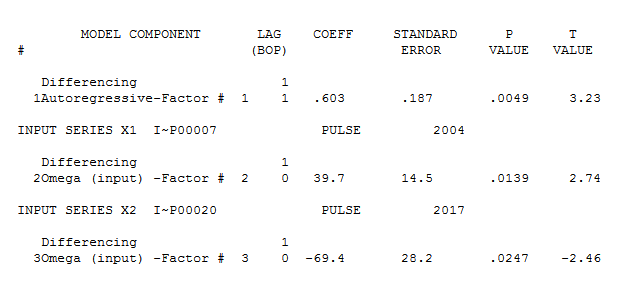I have tried forecasting next 13 years data point by using past 20 years data (1998-2010) available in the following graphs. I used three models to compare- linear regression, exponential regression, and ARIMA. In the first image ARIMA tend to fit the data well and prediction is clearly better than other two models. In the second image though ARIMA fits the data well, but none seems to have a good prediction. I think as in the final year, data had a sharp fall, ARIMA showing a sharp decrease in the next years as well! However, it had a increasing trend in the previous 18 years! Any idea?
My second question is- is there any situation where Linear or Exponential regression can better predict than ARIMA model?
dput(<br/>
data<-c(1796.0, 1737.0, 1745.0, 1829.0, 1857.0, 1885.0, 2088.0, 2112.0, 2137.0, 2150.0, 2168.0, 2219.0, 2233.0, 2249.3, 2291.5, 2307.3, 2325.4,
2379.7, 2385.3, 2407.0) <br/>
data<-ts(data,start=1998) <br/>
fit.arima<-auto.arima(data)<br/>
fcast.arima<- forecast(fit.arima)<br/>
autoplot(data) +
autolayer(fitted(fit.arima), series = "arima") +
autolayer(fcast.arima, series="arima", PI=FALSE) +
xlab("Year") + ylab("Employment") +
ggtitle("") +
guides(colour = guide_legend(title = " "))<br/>
)
dput(<br/>
data<-c(1090.0,1118.0, 1135.0,1218.0,1255.0,1275.0,1391.0,1424.0,1432.0,1430.0,
1447.0,1468.0,1471.0,1507.2,1520.5,1526.4,1524.4,1545.6,1539.0,1466.4)<br/>
data<-ts(data,start=1998) <br/>
fit.arima<-auto.arima(data) <br/>
fcast.arima<- forecast(fit.arima) <br/>
autoplot(data) +
autolayer(fitted(fit.arima), series = "arima") +
autolayer(fcast.arima, series="arima", PI=FALSE) +
xlab("Year") + ylab("Employment") +
ggtitle("") +
guides(colour = guide_legend(title = " "))<br/>
)















dput()on whatever you submit toauto.arima(). $\endgroup$